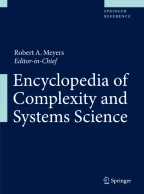Definition of the Subject
The importance of evolution can hardly be overstated. As the Jesuit priest Pierre Teilhard de Chardin put it,
Evolution is a general postulate to which all theories, all hypotheses, all systems must hence forward bow and which they mustsatisfy in order to be thinkable and true. Evolution is a light which illuminates all facts, a trajectory which all lines of thought mustfollow – this is what evolution is.
Darwin's evolution theory is based on three fundamental principles: reproduction, mutation and selection, which describe how populations change overtime and how new forms evolve out of old ones. Starting with W. F. R. Weldon, whom at the beginning of the 20th century realized that “the problemof animal evolution is essentially a statistical problem”, and blooming in the 30's with Fisher, Haldane and Wright, numerous mathematicaldescriptions of the resulting evolutionary dynamics have been proposed, developed and studied. Deeply engraved in these frameworks...
Abbreviations
- Evolutionarily stable equilibria (ESS):
-
An ESS is a set of frequencies of different types of individuals in a population that can not be invaded by the evolution of a single mutant. It is the evolutionary counterpart of a Nash equilibrium.
- Fitness landscape:
-
A metaphorical description of fitness as a function of individual's genotypes or phenotypes in terms of a multivariable function that does not depend on any external influence.
- Genetic locus:
-
The position of a gene on a chromosome. The different variants of the gene that can be found at the same locus are called alleles.
- Nash equilibrium:
-
In classical game theory, a Nash equilibrium is a set of strategies, one for each player of the game, such that none of them can improve her benefits by unilateral changes of strategy.
- Scale free network:
-
A graph or network such that the degrees of the nodes are taken from a power-law distribution. As a consequence, there is not a typical degree in the graph, i.?e., there are no typical scales.
- Small-world network:
-
A graph or network of N nodes such that the mean distance between nodes scales as \( { \log N } \). It corresponds to the well-known “six degrees of separation” phenomenon.
Bibliography
Primary Literature
Barabási A-L, Albert R (1999) Emergence of scaling in random networks. Science 286:509–512
Drossel B (2001) Biological evolution and statistical physics. Adv Phys 50:209–295
Fisher RA (1958) The Genetical Theory of Natural Selection, 2nd edn. Dover, New York
Gintis H (2000) Game Theory Evolving. Princeton University, Princeton
Hauert C (2002) Effects of space in \( { 2\times 2 } \) games. Int J Bifurc Chaos 12:1531–1548
Hauert C, Doebeli M (2004) Spatial structure often inhibits the evolution of cooperation in the snowdrift game. Nature 428:643–646
Hendry AP, Kinnison MT (1999) The pace of modern life: Measuring rates of contemporary microevolution. Evolution 53:1637–1653
Hofbauer J, Sigmund K (1998) Evolutionary Games and Population Dynamics. Cambridge University, Cambridge
Hofbauer J, Sigmund K (2003) Evolutionary game dynamics. Bull Am Math Soc 40:479–519
Kimura M (1983) The Neutral Theory of Molecular Evolution. Cambridge University, Cambridge
Maynard-Smith J (1982) Evolution and the Theory of Games. Cambridge University, Cambridge
Maynard-Smith J, Price GR (1973) The logic of animal conflict. Nature 246:15–18
Moran PAP (1962) The Statistical Processes of Evolutionary Theory. Clarendon, Oxford
Nash JF (1950) Equilibrium points in n-person games. Proc Natl Acad Sci USA 36:48–49
Nowak MA (2006) Evolutionary Dynamics: Exploring the Equations of Life. Harvard Univ Press, Harvard
Nowak MA, May R (1992) Evolutionary games and spatial chaos. Nature 359:826–829
Nowak MA, Sasaki A, Taylor C, Fudenberg D (2004) Emergence of cooperation and evolutionary stability in finite populations. Nature 428:646–650
Page K, Nowak MA (2002) A unified evolutionary dynamics. J Theor Biol 219:93–98
Roca CP, Cuesta JA, Sánchez A (2006) Time scales in evolutionary dynamics. Phys Rev Lett 97: art. no. 158701
Roca CP, Cuesta JA, Sánchez A (2007) The importance of selection rate in the evolution of cooperation. Eur Phys J Special Topics 143:51–58
Santos FC, Pacheco JM, Lenaerts T (2006) Evolutionary dynamics of social dilemmas in structured heterogeneous populations. Proc Natl Acad Sci USA 103:3490–3494
Skyrms B (2003) The Stag Hunt and the Evolution of Social Structure. Cambridge University, Cambridge
Szabó G, Fáth G (2007) Evolutionary games on graphs. Phys Rep 446:97–216
Sánchez A, Cuesta JA (2005) Altruism may arise by individual selection. J Theor Biol 235:233–240
Watts DJ, Strogatz SH (1998) Collective dynamics of “Small World” Networks. Nature 393:440–442
Wright S (1932) The roles of mutation, inbreeding, crossbreeding and selection in evolution. Proc 6th Int Cong Genet 1:356–366
Books and Reviews
Nowak M, Sigmund K (2004) Evolutionary dynamics of biological games. Science 303:793–799
Taylor PD, Jonker L (1978) Evolutionarily stable strategies and game dynamics. J Math Biosci 40:145–156
von Neumann J, Morgenstern O (1944) Theory of Games and Economic Behavior. Princeton University Press, Princeton
Author information
Authors and Affiliations
Editor information
Editors and Affiliations
Rights and permissions
Copyright information
© 2009 Springer-Verlag
About this entry
Cite this entry
Sánchez, A. (2009). Perturbation of Equilibria in the Mathematical Theory of Evolution. In: Meyers, R. (eds) Encyclopedia of Complexity and Systems Science. Springer, New York, NY. https://doi.org/10.1007/978-0-387-30440-3_394
Download citation
DOI: https://doi.org/10.1007/978-0-387-30440-3_394
Publisher Name: Springer, New York, NY
Print ISBN: 978-0-387-75888-6
Online ISBN: 978-0-387-30440-3
eBook Packages: Physics and AstronomyReference Module Physical and Materials ScienceReference Module Chemistry, Materials and Physics
